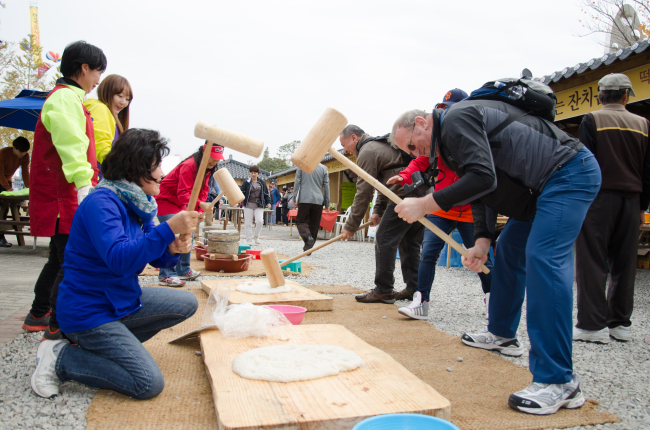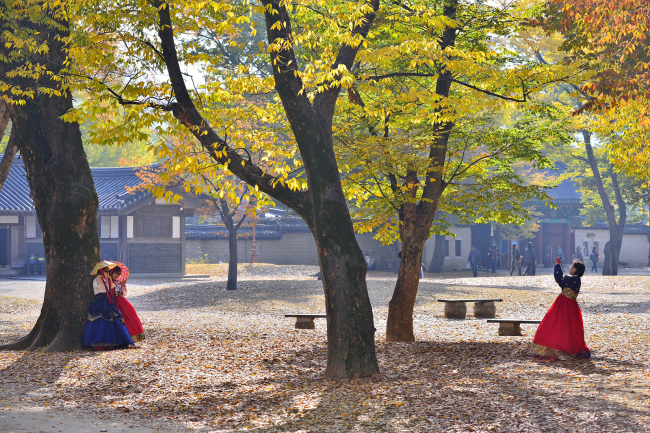[Herald Interview] Jeonju, an intersection of tradition and innovation
Jeonju, an intersection of tradition and innovation
By Korea HeraldPublished : Oct. 13, 2016 - 16:51
In an era when a nation’s competitiveness has come to be defined by that of individual cities, it is crucial that each city preserves its uniqueness rather than mimic other major cities, according to the mayor of Jeonju, North Jeolla Province.
The southwestern city, known for its traditional elements such as bibimbap, makgeolli, hanok, hanbok and local festivals, was selected by Lonely Planet in August this year as one of Asia’s top three tourist spots. US news broadcaster CNN also released a report on Jeonju as a distinctive destination when visiting South Korea.
The southwestern city, known for its traditional elements such as bibimbap, makgeolli, hanok, hanbok and local festivals, was selected by Lonely Planet in August this year as one of Asia’s top three tourist spots. US news broadcaster CNN also released a report on Jeonju as a distinctive destination when visiting South Korea.

“Though we were always confident about the domestic public’s perception of Jeonju, we were not quite certain of the response from the international society,” the city’s Mayor Kim Seung-su told The Korea Herald in an interview.
“But the recent CNN report has confirmed our belief that our city indeed has much to offer to visitors.”
What really counts, according to the mayor, is that Jeonju earned the positive reviews by preserving and focusing on what it already had instead of building artificial commercial facilities.
“But the recent CNN report has confirmed our belief that our city indeed has much to offer to visitors.”
What really counts, according to the mayor, is that Jeonju earned the positive reviews by preserving and focusing on what it already had instead of building artificial commercial facilities.

“Our key strategy, should there be any, is to expose Jeonju exactly as it is, no disguise, no distortion,” Kim said.
“And no amusement parks, casinos or mega-sized shopping complexes are needed for this.”
City of bibimbap and hanok
Jeonju has acted upon such belief. It earned two international titles based on its two most famous cultural features -- traditional food and architecture.
“And no amusement parks, casinos or mega-sized shopping complexes are needed for this.”
City of bibimbap and hanok
Jeonju has acted upon such belief. It earned two international titles based on its two most famous cultural features -- traditional food and architecture.

In 2012, the city was named by UNESCO as a Creative City for Gastronomy. There are currently a handful of designated creative cities in South Korea -- Seoul for design, Busan for film, Icheon for crafts and folk art, Gwangju for media art and Jeonju.
When making the selection, the international organization cited Jeonju’s ample yield in rice from the Honam Plain, fish from the West Sea and fresh vegetables and greens from the mountains, as well as the city’s history of preserving the country’s food culture.
The most eye-catching occasion in the food sector is the upcoming bibimbap festival, a yearly event to be held Oct. 20-23.
“Considering foreigners’ improved recognition of this food genre, we will no longer limit the festival contents to gastronomic experiences, but expand into new cultural exchange and communication,” the mayor said.
For instance, local residents from each of the 33 administrative districts of the city will create an original recipe of bibimbap to offer at the festival. This program was initiated so as to underline the concept of harmony and community sharing incorporated in the menu, the city chief explained.
Also, the city was reauthorized this year as a “slow city” by Cittaslow International, an international network of Slow Cities, in recognition of its efforts to maintain sustainable growth based on traditions and nature.
By doing so, Cittaslow expanded the range of its certification from Jeonju Hanok Village to the entire city, making it the first of such cases in a city with a population of 600,000 or more.
When making the selection, the international organization cited Jeonju’s ample yield in rice from the Honam Plain, fish from the West Sea and fresh vegetables and greens from the mountains, as well as the city’s history of preserving the country’s food culture.
The most eye-catching occasion in the food sector is the upcoming bibimbap festival, a yearly event to be held Oct. 20-23.
“Considering foreigners’ improved recognition of this food genre, we will no longer limit the festival contents to gastronomic experiences, but expand into new cultural exchange and communication,” the mayor said.
For instance, local residents from each of the 33 administrative districts of the city will create an original recipe of bibimbap to offer at the festival. This program was initiated so as to underline the concept of harmony and community sharing incorporated in the menu, the city chief explained.
Also, the city was reauthorized this year as a “slow city” by Cittaslow International, an international network of Slow Cities, in recognition of its efforts to maintain sustainable growth based on traditions and nature.
By doing so, Cittaslow expanded the range of its certification from Jeonju Hanok Village to the entire city, making it the first of such cases in a city with a population of 600,000 or more.

“This shows that Jeonju is a model example of an urban slow city, achieving the ideal balance of traditional culture, nature, and sustainable growth potentials,” Kim said.
But the city should also take caution not to be swept away by the soaring popularity of Korean traditional homes – hanok -- the mayor said in a warning message.
“I do not intend to build a new hanok village just to meet tourist demands,” he said.
The core of his redevelopment plan is to focus on the relatively underexploited city districts, a 3.3-kilometer-square urban area which embraces the city hall and a large number of neglected hanok in the vicinity.
“There are some 1,500 hanok that are aged 30 years or more nearby the city hall, which is more than double the number in Hanok Village,” he said.
“These traditional houses, if well preserved, will turn into state-designated cultural assets within two decades.”
Self-sustaining, growing, and inspiring
In this year’s UNESCO Creative City Network meeting, held in Sweden last month, Jeonju announced the Jeonju Food Plan 2025, a 10-year program aiming to boost the consumption of local food and to promote the self-sufficiency of manufacturers.
“Our 660,000 citizens spend about 1 trillion won ($880 million) annually on their food bills, but only 50 billion won of this gross sum is produced in Jeonju,” the mayor said.
“The plan is about pulling up the ratio of locally produced and manufactured food to 20 percent, or 200 billion won, within 10 years.”
The city is also making aggressive investments in the carbon fiber industry, pledging to take the initiative in the long-term growth, high value-added sector.
“I am the third-generation mayor here to encourage the carbon fiber business, under the awareness that we need to pioneer new frontiers in order to create new, sustainable values,” said the mayor.
But the city should also take caution not to be swept away by the soaring popularity of Korean traditional homes – hanok -- the mayor said in a warning message.
“I do not intend to build a new hanok village just to meet tourist demands,” he said.
The core of his redevelopment plan is to focus on the relatively underexploited city districts, a 3.3-kilometer-square urban area which embraces the city hall and a large number of neglected hanok in the vicinity.
“There are some 1,500 hanok that are aged 30 years or more nearby the city hall, which is more than double the number in Hanok Village,” he said.
“These traditional houses, if well preserved, will turn into state-designated cultural assets within two decades.”
Self-sustaining, growing, and inspiring
In this year’s UNESCO Creative City Network meeting, held in Sweden last month, Jeonju announced the Jeonju Food Plan 2025, a 10-year program aiming to boost the consumption of local food and to promote the self-sufficiency of manufacturers.
“Our 660,000 citizens spend about 1 trillion won ($880 million) annually on their food bills, but only 50 billion won of this gross sum is produced in Jeonju,” the mayor said.
“The plan is about pulling up the ratio of locally produced and manufactured food to 20 percent, or 200 billion won, within 10 years.”
The city is also making aggressive investments in the carbon fiber industry, pledging to take the initiative in the long-term growth, high value-added sector.
“I am the third-generation mayor here to encourage the carbon fiber business, under the awareness that we need to pioneer new frontiers in order to create new, sustainable values,” said the mayor.

The international market’s demand for material safety will continue to increase, due to climate changes and consequently enhanced regulations, Kim claimed.
“Though South Korea and Jeonju have not yet reached the world’s top level in carbon technology, it is significant that we have managed to manufacture related goods without relying on imports, all this in just over a decade.”
Hyosung, the nation’s ranking conglomerate in the textile business, is currently operating a carbon fiber manufacturing plant in Jeonju.
Historic, yet young and vigorous
For a city with a history of some 1,300 years and a long reputation for cultural heritage, Jeonju has an interesting twist -- its mayor being one of the youngest administrative leaders in the nation.
“Not only is our city old, but it is also quite conservative, which is why many were surprised when I was elected for my post back in 2014, as the youngest mayor then,” Kim said.
At the time, Jeonju was perplexed by a series of social disputes, ranging from never-ending strikes of public transport labor unions to the relocation of a local prison. A decades-long prostitution area at the heart of the city was also considered a major obstacle to the growing tourism business.
“I thought (my election) was a message that the people wanted a young, innovative figure to step in and take some bold actions,” the 47-year-old mayor said.
One of his signature projects was to transform the red-light district into a cultural zone by expanding the public’s access to the area and supporting voluntary art programs there, instead of relying on forceful eviction.
“It is not just because the district defames the image of the city in the eyes of tourists, but because it stands for the violation of women’s rights and violence in our society,” he said.
He is also working on a project to renew the Jeonju Train Station, promoting it as a comprehensive information center and cultural space representing the entire province.
“Jeonju Station is often recognized by its hanok-style appearance, but this is but a superficial gesture, as the building currently fails to meet the diversifying needs of visitors,” he said.
The station, according to the ambitious mayor, should be more than just a platform for transport. It should also be a channel through which visitors can better experience the city and the surrounding region.
“For this we not only need to build a whole new space, but also should build information centers, craft shops, rest areas, all equipped with sufficient infrastructure, data and translation manpower.”
There was once a time when a city’s profile was almost entirely dependent on the state to which it belonged. This is no longer the case, the city leader stressed.
“It may not be an exaggeration to say that it is now individual cities that decide the reputation of the nation itself,” Kim said.
“This is why it is important for every city to stand on its own feet, facing and developing its forte, instead of depending on the central government.”
By Bae Hyun-jung (tellme@heraldcorp.com)
“Though South Korea and Jeonju have not yet reached the world’s top level in carbon technology, it is significant that we have managed to manufacture related goods without relying on imports, all this in just over a decade.”
Hyosung, the nation’s ranking conglomerate in the textile business, is currently operating a carbon fiber manufacturing plant in Jeonju.
Historic, yet young and vigorous
For a city with a history of some 1,300 years and a long reputation for cultural heritage, Jeonju has an interesting twist -- its mayor being one of the youngest administrative leaders in the nation.
“Not only is our city old, but it is also quite conservative, which is why many were surprised when I was elected for my post back in 2014, as the youngest mayor then,” Kim said.
At the time, Jeonju was perplexed by a series of social disputes, ranging from never-ending strikes of public transport labor unions to the relocation of a local prison. A decades-long prostitution area at the heart of the city was also considered a major obstacle to the growing tourism business.
“I thought (my election) was a message that the people wanted a young, innovative figure to step in and take some bold actions,” the 47-year-old mayor said.
One of his signature projects was to transform the red-light district into a cultural zone by expanding the public’s access to the area and supporting voluntary art programs there, instead of relying on forceful eviction.
“It is not just because the district defames the image of the city in the eyes of tourists, but because it stands for the violation of women’s rights and violence in our society,” he said.
He is also working on a project to renew the Jeonju Train Station, promoting it as a comprehensive information center and cultural space representing the entire province.
“Jeonju Station is often recognized by its hanok-style appearance, but this is but a superficial gesture, as the building currently fails to meet the diversifying needs of visitors,” he said.
The station, according to the ambitious mayor, should be more than just a platform for transport. It should also be a channel through which visitors can better experience the city and the surrounding region.
“For this we not only need to build a whole new space, but also should build information centers, craft shops, rest areas, all equipped with sufficient infrastructure, data and translation manpower.”
There was once a time when a city’s profile was almost entirely dependent on the state to which it belonged. This is no longer the case, the city leader stressed.
“It may not be an exaggeration to say that it is now individual cities that decide the reputation of the nation itself,” Kim said.
“This is why it is important for every city to stand on its own feet, facing and developing its forte, instead of depending on the central government.”
By Bae Hyun-jung (tellme@heraldcorp.com)
-
Articles by Korea Herald





![[Music in drama] Rekindle a love that slipped through your fingers](http://res.heraldm.com/phpwas/restmb_idxmake.php?idx=644&simg=/content/image/2024/05/01/20240501050484_0.jpg&u=20240501151646)




![[New faces of Assembly] Architect behind ‘audacious initiative’ believes in denuclearized North Korea](http://res.heraldm.com/phpwas/restmb_idxmake.php?idx=644&simg=/content/image/2024/05/01/20240501050627_0.jpg&u=20240502093000)








